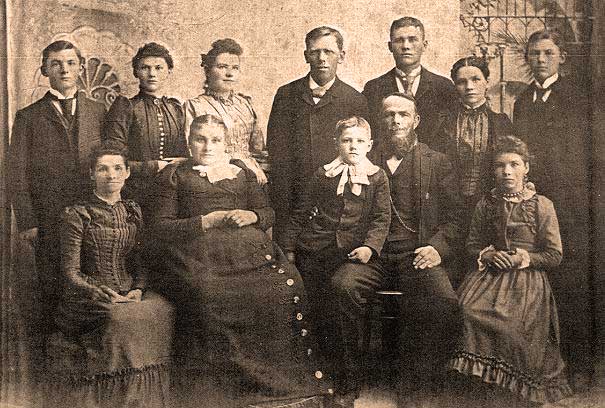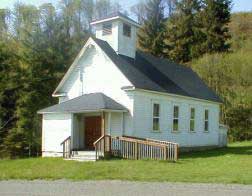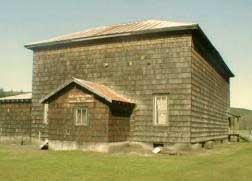
Churches of Christ & Christian Churches in the Pacific Northwest GRAYS HARBOR COUNTY, WASHINGTON |
 Sept. 16, 2003 by Charles Dailey College index |
Aberdeen | Elma | Hoquiam | Johns River | Montesano
Chehalis County was renamed Grays Harbor County in 1915.Elma Map
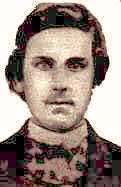
Church Planter
John RigdonThe First Christian Church in Elma has mutated into the Grace Community Church. It began in 1856 - the first church of any kind in town. Two Oregon preachers focused on Elma -- Lewis Casteel and John Rigdon. John was a graduate of Alexander Campbell's Bethany College in West Virginia. While many Bethany graduates went into teaching college, Rigdon had some vision problems and chose to be a circuit-riding preacher.
There is a profile of John Rigdon.Eben Sherwood was the first minister of the congregation. He would drive an ox team and wagon from his home in Satsop to Elma. The trails were so poor that at times it would take him five to six hours each way. The church probably met in public buildings until 1878 when it built its own building at Seventh and Waldrip.
We are able to learn the names of a few members by obituaries published in the Elma Chronicle. They included: John R. and Lucy Craig, Mr. and Mrs. Edd Jessup, Mrs. L. W. Parkhurst, William H. and Helen (Himes) Ruddell, Adeline E. (Mrs. Thomas) Taylor, Mr. and Mrs. Edward G. White, and Mary C. Winders. The church building was later located at 5th and West Main.
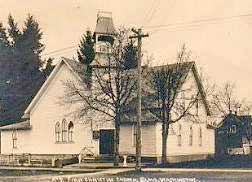
Elma Christian Church Well-known members of the congregation included William Henry and Helen Himes Ruddle. He was a pioneer and the son of pioneer Stephen Ruddle of Chambers Prairie near Olympia and she was the daughter of pioneer Tyrus and Emiline Himes. He had emigrated to Washington Territory in 1851 and she in 1853. Their home was the first frame house in the county.
Helen Ruddle's brother, Judson Wickliffe Himes, also settled at Elma. He had come overland at the age of three in 1853. Judson farmed, logged, worked for the railroad, sold farm equipment, and finally insurance and also served as Justice of the Peace.
The preacher in 1885 was W. W. Watson.
Johns River Map
Jason Fry, his brothers and friends conducted logging operations in the Johns River valley beginning in 1882. Jason was the son-in-law of William Huntington of Castle Rock. He preached on weekends until his death in 1889.
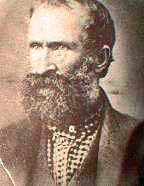
Jason Fry Jason Fry was a man of parts and would have been outstanding in any generation, as he was in his own. He was a thorough student, though one with little formal education. He was an industrious reader, well versed in the Bible and had a working knowledge of law. He served often as preacher and camp-meeting minister. Early Grays Harbor newspapers frequently carried notices of religious meetings a which Jason Fry would talk. He often spent entire weekends traveling from one camp meeting to another, and from one end of the country to the other. Less frequently, but with equal ease and familiarity he acted as attorney and judge in pioneer courts.Jason was an accomplished surveyor, and won credit for himself with work done in Portland and in some of the first surveys on the Quinault reservation. He was also farmer, blacksmith, carpenter, engineer, cattleman and logger. He was a man greatly respected, not only among his own people, but by the Indians as well. They sought his advice on both personal and tribal matters. He was renowned among them as a man of his word, and his word was held in the highest regard.
Our People by Edwin Van Syckle, page 60, and printed by Valley Press, Puyallup, WA. The book also contains photos and a genealogy of the Fry families.
There is information on the earlier years of Jason Fry in our Rainier, Oregon entry.
After Jason's death, his brother Harvey came west and devoted himself to preaching the gospel. Harvey came overland by train twice, the first time in 1888. The second trip was in an emigrant car with his daughter Thirza Atwood, her husband and their five children, Also on the trip were Harvey's sons Marion, Charley and Lewis. Their group handled their own food, bedding and baggage.
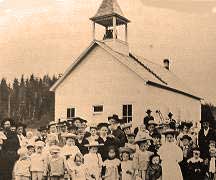
Church on Johns River Harvey, a blacksmith by trade, had been ordained to the ministry and was preaching in Iowa before coming to Grays Harbor County. He had been converted to Christ in 1851 and had been a member of the Red Oak Christian Church in Illinois before moving on to Iowa and Kansas.
In 1893, because the Frys and their relatives had established a considerable colony on Johns River, Harvey Fry and his son-in-law Frank Hutton built a Christian denomination church in the valley.
- Page 127, The River Pioneers by Edwin Van Syckle, Pacific Search Press, 1982.
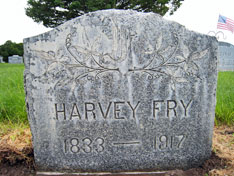
Marker in the Dubois Cemetery
-- Courtesy of Judy O'BrienThe building was 24 by 40-foot. The seats were clear spruce and able to seat 120 people.
Harvey Fry spent his remaining years preaching on Johns River. He visited outlying communities for years, always with his faithful rifle in his rowboat. If he spotted a deer or other game in his travels, he bagged it for the people at his next stop.
While visiting his children in Dubois, Idaho he suffered a stroke and died at age 84. He is buried in the Dubois Cemetery.
Porter MapThe town was named in honor of an early settler, Corydon R. Porter.
We believe that the church at Sharon is the same as the church at Porter. W. H. Lewis writes to the Christian Record in 1875 that "We have 17 members in this place (Sharon). We organized last June."
Among the earliest members of the Porter Church of Christ were Hiram and Zimry Witsman, plains-trekkers from Clay County, Illinois. David Reeves, their nephew, functioned in the role of Justice of the Peace and minister as his name is signed on several early marriages certificates using both of those titles.
David
ReevesHe and his party arrived via San Francisco and Portland in 1875 according to a local historian Margaret Haapanen.
The ancient building of the Church of Christ still stands on Porter Street. It has been kept in good repair and is easily seen as one drives north on U. S. Highway 12. The congregation was organized about 1873 and numbered 34 members in 1877.
There is a photo of the David Reeves family. It is large and may take 15 seconds to load.
Another family connected with early days was Rolander L. and Mary Gross Shelley. He was a son of Michael Shelley of Oregon.
The Church of Christ
building in PorterThe church may have started meeting in a local school house and eventually built the building on Porter Street. It does not meet now.
An early handwritten membership list records: R. O. and Mary Beckworth; Jesse and Bessie Chapell; A. J., Tilda, Bertha, Lena, Jennie, Lee and Hulda Gibson; Teafilo & Ida Longore (Longoria); H. J. and Hattie Malone; John, Annie, George A., Edith and Laura McMaster; Clara Mooney; Ruby and Rena Nicholson; Ruth Margaret and J. B. Ray; Hannah Reeves; Elizabeth, Joe, Margaret and Otto Rucker; Ira E., Jessie and Annie Simmons; and William, Lewis, Oliver and Della Wilder. We are not able to determine husband and wife relationships for this list except where the "&" sign appears.
In 1885 they did not have a preacher, met once each month, and reported a membership of 27.
The reader may want to examine the names of those buried in the Sharon Cemetery at Porter, including the Gibson, Lemmon, McMaster, Reeves, Wilder and Witsman families. These were members of the Porter Church of Christ.Oakville MapScrubby White Oak was once common the vicinity, so the town was tagged with the name of Oakville. It is in the extreme southeast corner of Grays Harbor County.
The Christian Church
met in this building on
Temple Street when it
was a school house.The Oakville Christian Church met in the school house. It left little record behind and closed early in the 1900's. "Dr." James Harrison & Emeline Roundtree were at times among the members. He was the first Justice of the Peace and later the first Probate Judge of Chehalis (now Grays Harbor) County. He became doorkeeper of the House of Representatives at the first session of the Territorial Legislative Assembly in Olympia in 1854.
In July of 1874, Dr. Roundtree wrote to the Christian Record:
Bro. Bailes, of Oregon, organized a church here to be known as "Cedarville Church." He immersed 5 persons during the meeting. Brethren E. B. Couch and W. H. Lewis are our overseers, and I am deacon. We expect Bro. Bailes to visit us again, and hold another meeting for us in September or October next.This places the beginning of the church in 1874. Evidently the name "Cedarville Church" did not stick.The Roundtrees owned a farm just east of Oakville. He then moved to Centralia, but in his later years, he returned and opened a drugstore in Oakville. J. H. and Emeline are buried in the Mt. View Cemetery in Centralia.
The daughter of Stephen D. Ruddell also moved to Oakville. For more about him, see the Thurston County chapter -- Lacey entry. Catherine Ruddle had married Augustus Balch and they had settled here. In all, they had 14 living children. Several of them and Augustus were drowned in river-related accidents.
Montesano Map
This community, eight miles east of Aberdeen, has a Spanish name meaning health mountain or something similar.
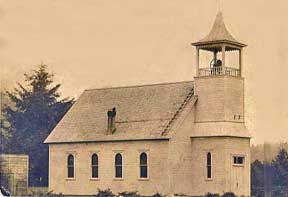
Christian Church in 1907
Little local information is available about the Stone-Campbell related church that once met in Montesano. The preacher in 1885 was Thomas O. Morgan. That was very close to the founding year of the congregation.
According to the Chehalis County Call, of February 20, 1912, the Christian Church building was constructed in 1906 when Mr. Hutton was the minister. This was Frank D. Hutton mentioned in the Johns River article above. The building was located at the northeast corner of Sylvia Street North and Spruce Avenue East.
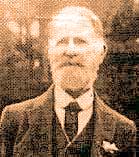
Marcellus Luark
Photo courtesy of
The Montesano VidetteOne prominent pioneer member was Marcellus Luark who came to Washington in 1853. He moved first near Centralia, then moved several more times, eventually settling at Montesano.
He married Frances Redman in 1867. Tragically, she died four years later. At the time of his death, he was an active member of the Christian Church in Montesano. At an earlier time in his life, he had been a Methodist minister.
Hoquiam Map
The community was established in 1859 and its name is an Indian word meaning hungry for wood because of the driftwood near by.
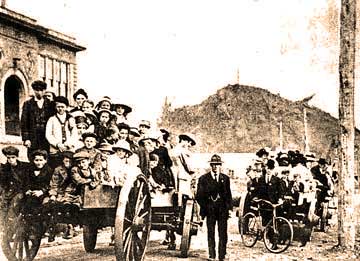
Photo courtesy of the Polson Museum In a 1971 unpublished history by Winifred Herrington (and provided to us by Jim Lawson) it is reported that the congregation began in 1903 when the J. R. Riggs family arrived from the midwest. A hall was rented and a 10-night meeting was conducted by Arthur C. Vail. Following the meeting, 20 charter members were organized into the Pioneer Church of Christ of Hoquiam.
We assume that the building in the photo is the Pioneer Church meeting house and probably the gentleman in the center of the photo with the watch fob is the preacher. He may have been R. M. Messick, the first located preacher.
The building was erected at the northeast corner of Karr and Garfield in 1906. By 1916, the church had built a hall next to the main building. After church growth and remodeling, the church combined with the Aberdeen congregation in 1971.
Historian Orval Peterson writes:
A. C. Vail came to assist this small body of Christians, and L. P. Hovis was an early convert. The Disciples asked to use the baptistry in the Baptist church, but the minister refused permission. Hoquiam gets its water supply from a reservoir on a big hill. The reservoir leaked, and a stream of water coursed down the hill.Aberdeen MapThese Disciple pioneers were not to be defeated, so they dug a large hole at the foot of the hill, boarded it up, and made it into a baptistry. They then turned the stream of water from the reservoir into the hole. In this unique baptistry, L. P. Hovis was baptized before a large congregation attracted by the outdoor service.
Later, a more charitable Baptist minister came to Hoquiam and he shared his facilities with the Disciples. Among these early laborers in the Hoquiam Christian church were Mr. and Mrs. J. R. Riggs, to whom we are indebted for this story.
The Aberdeen Church of Christ was organized by J. M. Mooris with a gospel meeting in the summer of 1905. There were soon 40 members. In September of that year David E. Olson came to Aberdeen to continue the work. He conducted a night-to-night meeting and another 65 were added.
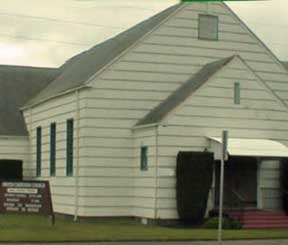
Aberdeen Christian Church building.
The reader will need to visualize the
original building before the additions
were made and new siding installed.In November, an "Elder Harris" came for a few months and then local men began the regular preaching. The original building was at West Market and North L, on the north corner of the intersection.
In 1911, the church dedicated its own new building at W.1st and North L Streets.
Next Chapter: King County or back to Pioneer Menu


